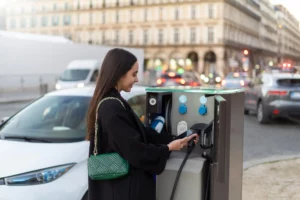
Home / EV Charging News / The Critical Role of Dual Port Chargers in Public EV Infrastructure
As electric vehicles (EVs) become increasingly popular, the demand for efficient and accessible public charging infrastructure has surged. One of the most significant developments in this space is the introduction of dual port chargers. These chargers, which allow two vehicles to charge simultaneously from a single unit, are playing a critical role in meeting the growing needs of EV drivers and supporting the widespread adoption of electric vehicles. This article explores the importance of dual port chargers in public EV infrastructure, highlighting their benefits, challenges, and the future outlook for their integration into the charging ecosystem.
The global push towards reducing carbon emissions and promoting sustainable transportation has led to a rapid increase in the number of electric vehicles on the road. As a result, the demand for charging stations has intensified. Public charging infrastructure must evolve to keep pace with this growing fleet of EVs, ensuring that drivers have convenient and reliable access to charging facilities. Dual port chargers have emerged as a vital solution to address this need, offering a range of advantages that make them indispensable in the modern EV landscape.
Dual port chargers provide several key benefits that enhance the efficiency and convenience of public charging infrastructure.
Despite their numerous benefits, the deployment of dual port chargers also presents several challenges that must be addressed to maximize their effectiveness.
One significant challenge is ensuring that the electrical infrastructure can support the increased power demand. Dual port chargers require robust electrical systems capable of delivering adequate power to two vehicles simultaneously. Upgrading existing infrastructure can be costly and complex, requiring coordination between utility companies, charging network operators, and local governments.
Additionally, the management of charging sessions becomes more critical with dual port chargers. Effective software solutions are needed to optimize the allocation of charging slots, prevent conflicts, and manage peak demand periods. Advanced network management systems that incorporate real-time monitoring and dynamic load balancing can help address these issues, ensuring a seamless and efficient charging experience for users.
The future of dual port chargers looks promising, with ongoing advancements in technology and increasing support from governments and industry stakeholders. As battery technology improves and charging speeds increase, dual port chargers will become even more effective in meeting the needs of EV drivers.
Future trends include:
Dual port chargers play a critical role in the development of public EV infrastructure, offering a range of benefits that address the growing demand for efficient and accessible charging solutions. By maximizing space efficiency, reducing costs, and enhancing the user experience, these chargers are helping to drive the adoption of electric vehicles. However, the successful deployment of dual port chargers requires careful consideration of the challenges associated with electrical infrastructure and charging session management. As technology continues to advance and support for sustainable transportation grows, dual port chargers will become an increasingly important component of the EV charging ecosystem, paving the way for a greener and more sustainable future.
